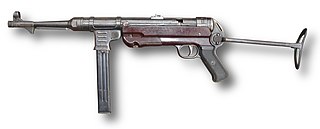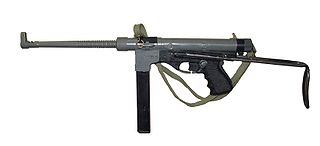
A submachine gun (SMG) is a magazine-fed automatic carbine designed to fire handgun cartridges. The term "submachine gun" was coined by John T. Thompson, the inventor of the Thompson submachine gun, to describe its design concept as an automatic firearm with notably less firepower than a machine gun. As a machine gun must fire rifle cartridges to be classified as such, submachine guns are not considered machine guns.

The Thompson submachine gun is a blowback-operated, selective-fire submachine gun, invented by United States Army brigadier general John T. Thompson in 1918. It was originally designed to break the stalemate of trench warfare of World War I, but early models did not arrive in time for combat.
Uzi most commonly refers to an Israeli submachine gun family.

The MP 40 is a submachine gun chambered for the 9×19mm Parabellum cartridge. It was developed in Nazi Germany and used extensively by the Axis powers during World War II.
PM or pm is an abbreviation for Latin post meridiem, meaning "after midday" in the 12-hour clock.
M53, M-53, or M.53 may refer to:

The MAT-49 is a submachine gun which was developed by French arms factory Manufacture Nationale d'Armes de Tulle (MAT) for use by the French Army and was first produced in 1949.

A firearm is said to fire from an open bolt if, when ready to fire, the bolt and working parts are held to the rear of the receiver, with no round in the chamber. When the trigger is actuated, the bolt travels forward, feeds a cartridge from the magazine or belt into the chamber, and fires that cartridge in the same movement. Like any other self-loading design, the action is cycled by the energy released from the propellant, which sends the bolt back to the rear, compressing the mainspring in readiness for firing the next round. In an open-bolt gun firing semi-automatically, the bolt is caught and held at this point by the sear after each shot; and in automatic open-bolt fire, it's caught and held in this manner whenever the trigger is released. In contrast to this, in closed-bolt guns, the trigger and sear do not affect the movement of the bolt directly.

The MP 18 is a German submachine gun designed and manufactured by Bergmann Waffenfabrik. Introduced into service in 1918 by the German Army during World War I, the MP 18 was intended for use by the Sturmtruppen, assault groups specialized in trench combat, as a short-range offensive weapon that would provide individual soldiers with increased firepower over a pistol.

The Vigneron is a submachine gun manufactured in Belgium during the 1950s. It used the 9×19mm NATO cartridge and was used by the Belgian Army until the 1980s. The Vigneron is a selective-fire weapon for short-range street and brush fighting. It remains reasonably accurate up to 100 m using sighted semi-automatic fire.
The Sola is a submachine gun that was built by Societe Luxembourgeoise SA in Luxembourg between 1954 and 1957. It uses the 9×19mm Parabellum round and is capable of using MP 40-type magazines, which were popular around Europe at the time. This weapon saw service in Africa and several are still in use today.
The SIG MP310 is a submachine gun manufactured in Switzerland, developed from SIG's earlier wood stock MP46 design. Its magazine was able to fold forward 90 degrees under the gun barrel, and it was fitted with a collapsible wire buttstock.
Vigneron was a family of French bow makers. Notable members include Joseph Arthur Vigneron and Andre Vigneron.
Fétique was a family of French bow makers, notable members include Victor François Fétique, Jules Fétique both of whom were awarded Meilleur Ouvrier de France and Marcel Fétique.
André Vigneron was a French Archetier / Bowmaker.
Joseph Arthur Vigneron was an important French Archetier / Bowmaker.
Victor François Fétique was a prominent French archetier (bowmaker) from a family of bowmakers.
A bow maker is a person who builds, repairs, and restores ancient or modern bows for bowed string instruments. These include violins, violas, cellos, double basses, viola d'amore, viola da gamba, etc.

The Hotchkiss "type Universal" is a submachine gun manufactured in France after World War II. It was originally designed as a semi-automatic police carbine but a full automatic version was made. It fires from a closed bolt. Its most unique feature however is that it folds up into a very compact package and unfolds easily and relatively quickly. The semi-automatic version was exported in very limited numbers to many countries. Many were also exported to Venezuela and Morocco.
The Gevarm D4 is a submachine gun that was developed in 1956 by the French company Gévarm, a subsidiary of the Gévelot cartridge company. It was used by the French police and manufactured in limited quantities.
This page is based on this
Wikipedia article Text is available under the
CC BY-SA 4.0 license; additional terms may apply.
Images, videos and audio are available under their respective licenses.







